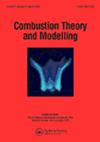Assessment of optimal reaction progress variable characteristics for partially premixed flames
IF 1.9
4区 工程技术
Q4 ENERGY & FUELS
引用次数: 3
Abstract
The reaction progress variable is a crucial concept in the advanced flamelet combustion models. As a controlling variable, a well-defined progress variable must consider the essential features of the combustion process. It is usually a heuristically defined linear combination of some major chemical species mass fractions. However, such a simple definition could lead to inaccurate results for the fuel-rich reactive mixtures or complicated fuels, due to the vast number of chemical species in the combustion process. In this paper, a new method for generating a reaction progress variable is proposed through solving a constrained optimisation problem. The proposed method uses a genetic algorithm with new constraints. The major new constraint is the minimisation of the inverse of a progress variable-based Damköhler number in addition to the minimisation of the gradients of a collection of chemical species concentrations, as used in the previous methods. Hence, this scheme increases the Damköhler number defined based on the progress variable. The applicability and performance of the current optimised progress variable are evaluated for ethanol–air partially premixed flames in an axisymmetric two-dimensional counterflow burner and a two-dimensional plugged flow triple-flame burner. The effects of the number of chemical species included in the progress variable and the flow field strain rate on a partially premixed ethanol–air flame prediction are investigated. Results indicate that including the progress variable Damköhler number in the determination of the progress variable has a considerable effect on the accuracy of Flamelet Generated Manifold (FGM) model prediction of fuel-rich and lean reactive mixtures, especially at higher strain rates. Also, it is shown that the inclusion of the critical chemical species for ignition and fuel decomposition processes, such as CH3O2, CH3CHO, sC2H4OH, HO2, H and H2O2, in the definition of progress variable has a significant effect on the accuracy of the ethanol–air flame predictions.部分预混火焰最佳反应过程变量特性的评估
在先进的小火焰燃烧模型中,反应过程变量是一个至关重要的概念。作为控制变量,定义明确的进度变量必须考虑燃烧过程的基本特征。它通常是一些主要化学物质质量分数的启发式定义的线性组合。然而,由于燃烧过程中存在大量化学物质,这种简单的定义可能会导致富燃料反应混合物或复杂燃料的结果不准确。本文通过求解一个约束优化问题,提出了一种生成反应进度变量的新方法。所提出的方法使用具有新约束的遗传算法。主要的新限制是,除了之前方法中使用的化学物质浓度集合的梯度最小化之外,基于进展变量的Damköhler数的倒数最小化。因此,该方案增加了基于进度变量定义的Damköhler数。对轴对称二维逆流燃烧器和二维塞流三火焰燃烧器中乙醇-空气部分预混火焰的当前优化进度变量的适用性和性能进行了评估。研究了进度变量中包含的化学物种数量和流场应变速率对部分预混乙醇-空气火焰预测的影响。结果表明,在确定过程变量时包括过程变量Damköhler数对富燃料和贫燃料反应混合物的小火焰生成歧管(FGM)模型预测的准确性有很大影响,尤其是在较高应变速率下。此外,研究表明,在进度变量的定义中包括点火和燃料分解过程的关键化学物质,如CH3O2、CH3CHO、sC2H4OH、HO2、H和H2O2,对乙醇-空气火焰预测的准确性有显著影响。
本文章由计算机程序翻译,如有差异,请以英文原文为准。
求助全文
约1分钟内获得全文
求助全文
来源期刊

Combustion Theory and Modelling
工程技术-工程:化工
CiteScore
3.00
自引率
7.70%
发文量
38
审稿时长
6 months
期刊介绍:
Combustion Theory and Modelling is a leading international journal devoted to the application of mathematical modelling, numerical simulation and experimental techniques to the study of combustion. Articles can cover a wide range of topics, such as: premixed laminar flames, laminar diffusion flames, turbulent combustion, fires, chemical kinetics, pollutant formation, microgravity, materials synthesis, chemical vapour deposition, catalysis, droplet and spray combustion, detonation dynamics, thermal explosions, ignition, energetic materials and propellants, burners and engine combustion. A diverse spectrum of mathematical methods may also be used, including large scale numerical simulation, hybrid computational schemes, front tracking, adaptive mesh refinement, optimized parallel computation, asymptotic methods and singular perturbation techniques, bifurcation theory, optimization methods, dynamical systems theory, cellular automata and discrete methods and probabilistic and statistical methods. Experimental studies that employ intrusive or nonintrusive diagnostics and are published in the Journal should be closely related to theoretical issues, by highlighting fundamental theoretical questions or by providing a sound basis for comparison with theory.
 求助内容:
求助内容: 应助结果提醒方式:
应助结果提醒方式:


